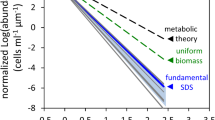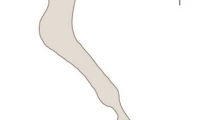Abstract
Using four replicate microcosms in the laboratory, we induced a phytoplankton bloom by enclosing a natural community sampled from Masnou Harbor (N.E. Spain) in November 1987, and examined the pattern of algal succession during the bloom. Good replicability of the temporal patterns of the community biomass and the abundance of most species demonstrated that succession was a directional, non-random process. The successional pathway observed (small flagellates » small centric diatoms » small flagellates) resembled that observed by other authors studying phytoplankton blooms. This pattern differed from previous models of algal succession in that dinoflagellates never comprised a substantial fraction of the community biomass, and in that algal cell size did not tend to increase along the successional sequence. Algal cell size, however, was an important determinant of phytoplankton community structure, since it constrained the density, but not the biomass, achievable by the different species. We suggest that there is not a single, general pattern of phytoplankton succession, but that distinction should be made, at least between seasonal and bloom patterns of phytoplankton succession.
Similar content being viewed by others
Literature cited
Agustí, S., Duarte, C. M., Kalff, J. (1987). Algal cell size and the maximum density and biomass of phytoplankton. Limnol. Oceanogr. 32: 983–986
Bailey-Watts, A. E., Kirika, A. (1981). The assessment of size variations in Loch Leven phytoplankton: methodology and some of its uses in the study of factors influencing size. J. Plankton Res. 3: 261–282
Brockmann, U. H., Eberlein, K., Hosumbek, P., Trageser, H., Maier-Reimer, E., Schöne, H. K., Junge, H. D. (1977). The development of a natural plankton population in an outdoor tank with nutrient-poor sea water. I. Phytoplankton succession. Mar. Biol. 43: 1–17
Cooke, G. D. (1967). The pattern of autotrophic succession in laboratory microcosms. BioSci. 17: 717–721
Duarte, C. M., Marrasé, C., Vaqué, D., Estrada, M. (1989). Counting error and the quantitative analysis of phytoplankton communities. (In preparation)
Estrada, M., Alcaraz, M., Marrase, C. (1987). Effects of turbulence on the composition of phytoplankton assemblages in marine microcosms. Mar. Ecol. Prog. Ser. 38: 267–281
Fuhrman, J., Eppley, R. W, Hagström, A., Azam, F. (1985). Diel variations in bacterioplankton, phytoplankton, and related parameters in the Southern California Bight. Mar. Ecol. Prog. Ser. 27: 8–20
Harris, G. P. (1985). Phytoplankton ecology. Structure, function, and fluctuation. Chapman Hall, London
Hulburt, E. M. (1983). The unpredictability of the marine phytoplankton. Ecology 64: 1157–1170
Ishizaka, J., Takahashi, M., Ichimura, S. (1983). Evaluation of coastal upwelling effects on phytoplankton growth by simulated culture experiments. Mar. Biol. 76: 271–278
Jassby, A. D., Goldman, C. R. (1974). A quantitative measure of succession rate and its application to the phytoplankton of lakes. Am. Nat. 108: 688–693
Lewis, W. M. (1978). Analysis of succession in a tropical phytoplankton community and a measure of succession rate. Am. Nat. 112: 401–414
Margalef, R. (1958). Temporal succession and spatial heterogeneity in phytoplankton. In: Buzzti-Traverso, A. A. (ed.) Perspectives in marine biology. University of California Press, Berkeley, p. 323–349
Margalef, R. (1967). The food web in the pelagic environment. Helgoländer wiss. Meeresunters. 15: 548–559
Margalef, R. (1974). Asociación o exclusión de la distribución de especies del mismo género en algas unicelulares. Mems R. Acad. Cienc. Artes Barcelona 47: 353–372
Margalef, R. (1978). Life-forms of phytoplankton as survival alternatives in an unstable environment. Oceanol. Acta 1: 493–509
Parsons, T. R., Harrison, P. J., Waters, R. R. (1978). An experimental simulation of changes in diatom and flagellate blooms. J. exp. mar. Biol. Ecol. 32: 285–294
Semina, H. J. (1968). Water movements and the size of phytoplankton cells. Sarsia 34: 267–272
Smayda, T. J. (1965). A quantitative analysis of the phytoplankton of the Gulf of Panamá. II. On the relationship between C14 assimilation and the diatom standing crop. Bull. inter-Am. trop. Tuna Commn. 9: 467–531
Smayda, T. J. (1980). Phytoplankton species succession. In: Morris, I. (ed.) The physiological ecology of phytoplankton. Blackwell, London, p. 493–570
Strickland, J. D. H., Parsons, T. R. (1972). A practical handbook of seawater analysis, 2nd ed. Bull. Fish. Res. Bd Can. 167: 1–310
Thomas, W. H., Pollock, M., Seibert, D. L. R. (1980). Effects of simulated upwelling and oligotrophy on chemostat-grown natural marine phytoplankton assemblages. J. exp. mar. Biol. Ecol. 45: 25–36
Travers, M. (1975). Le microplancton du golfe de Marseille: volume, surface et volume plasmique des organisms. Téthys 6: 689–712
Vaulot, D., Olson, R. J., Merkel, S., Chisholm, S. W. (1987). Cell-cycle response to nutrient starvation in two phytoplankton species, Thalassiosira weissflogii, and Hymenomonas carterae. Mar. Biol. 95: 625–630
Yentsch, C. S., Menzel, D. W. (1963). A method for the determination of phytoplankton chlorophyll and phaeophytin by fluorescence. Deep-Sea Res. 10: 221–231
Yentsch, C. S., Ryther, J. H. (1957). Short-term variations in phytoplankton chlorophyll and their significance. Limnol. Oceanogr. 2: 140–142
Author information
Authors and Affiliations
Additional information
Communicated by J. M. Pérès, Marseille
Rights and permissions
About this article
Cite this article
Marrasé, C., Duarte, C.M. & Vaqué, D. Succession patterns of phytoplankton blooms: directionality and influence of algal cell size. Marine Biology 102, 43–48 (1989). https://doi.org/10.1007/BF00391321
Accepted:
Issue Date:
DOI: https://doi.org/10.1007/BF00391321




